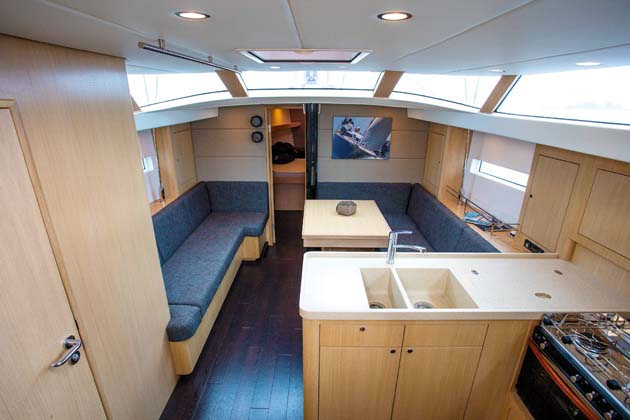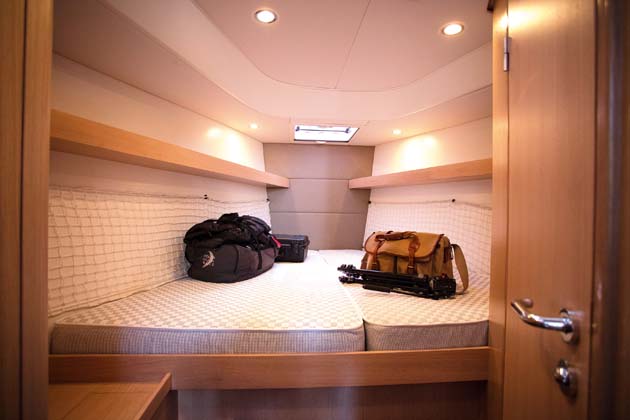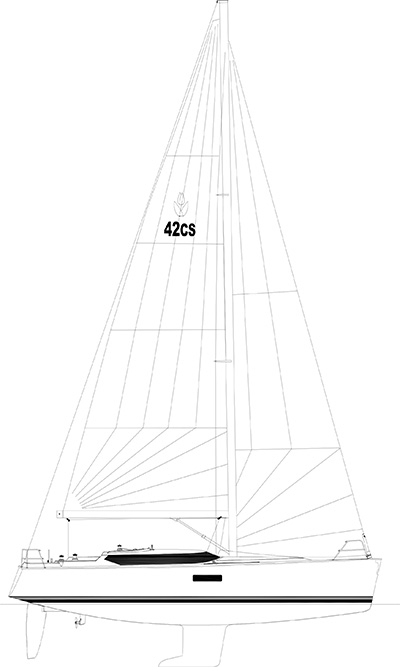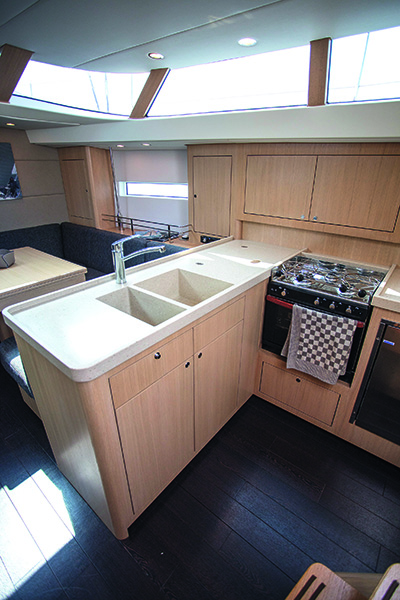Our mini-cruise aboard this impressive family cruiser demonstrated the quality of Dutch craftsmanship, reports Toby Hodges
Contest 42CS on test – a good looking cruiser from a family-run Dutch yard
Contest introduced a 42-footer to its range almost 40 years ago and it was considered a relative giant for a production yacht at the time. Today the 42CS is the smallest of the Dutch company’s range – exactly half the length of its newly announced flagship, the 84CS.
But here is a model that cleverly represents everything this third-generation, family-run yard stands for – a manageable-sized bluewater cruiser that has the options and attention to detail mastered from building larger vessels, and as such is an ideal introduction to the quality produced by time-honoured knowledge and skill.
A particularly good-looking craft, modish yet elegant, the 42CS has that clever knack of feeling like a larger boat than she is. During a visit to Contest’s Medemblik yard I had the opportunity to take an example for a mini cruise – a return trip out to the Frisian islands directly west of the IJsselmeer.
It was the ideal way to appreciate how this model is blessed with the pedigree of over half a century of builds. Contest is one of the largest and oldest family-run yards in the world, and conducts the whole build process on site – a yard with a rich past and a promising future.
Hitchhiking out to sea
The good thing about being confined to tight channels with a large tidal range is that, if you time things right, you can get a slingshot ride on your way – like turtles riding the Gulf Stream.
In such a manner we found ourselves enjoying a 2.5-knot tidal hitchhike as we spun out of Harlingen, the old fishing port north of the vast lock that controls the IJsselmeer’s marine traffic. On a rather still, light breeze afternoon, that sort of tide can do wonders for your apparent wind.
Our destination and overnight berth was the island of Vlieland, 20 miles off the giant dyke closing off the IJsselmeer. Our test boat, Tessa, had already completed a season in the UK and was bound for the Baltic this summer.
She is royally equipped – her owner has gone for a short-handed cockpit set-up, with single-point mainsheet, rigged so that all the sheets and running rigging can be managed from the helm. The powered coachroof-mounted winch has a remote switch by the helm, as does the jib furler. So within a couple of minutes and with minimal physical effort, the sails were raised.

It became obvious pretty quickly why the 42CS won the European Yacht of the Year award in 2014. She is a delight to sail. Tessa’s twin carbon wheels, linked with Jefa wire, produce a tactile, direct and communicative feel at the helm. In the calm conditions we could feel every knot’s increase in wind. Her stiff construction belies her modest 11 tonne displacement (40 per cent in the keel), and her tall mast indicates performance potential.
The afternoon Force 3 was from a direction just offwind enough that we could negotiate the barge-laden channel on port tack. When close-hauled we made between 6.2 and 6.4 knots at just over 30° to the apparent wind. This rose to 7 knots once the breeze hit double figures – which, with our friendly tide, equated to 9.5 to 9.9 SOG (speed over the ground).
Tessa is not only well-equipped with optional top of the range extras such as a carbon Seldén mast, furling boom, generator and electric winches, but the standard spec of most items, including running rigging, Andersen winches and Spinlock clutches, seems particularly high.
Although 42ft might seem comparatively small for a cruising yacht today, the top quality of the Contest’s build and fittings gives her a larger boat feel and a ‘little big boat’ mentality. It helps to explain why Tessa’s British owner downsized from his previous Oyster 49, after looking for something smaller. He didn’t want anything over 45ft for ease of handling, but still wanted top comfort down below.
Intoxicating experience
We conducted a photoshoot off Vlieland’s western shoreline for a couple of hours, where deep water continues right up to the beach. Sailing upwind at 7 knots towards miles of dry sand, before tacking or gybing away when just a couple of boatlengths off was rather a novel and intoxicating experience, but one I wouldn’t have attempted without having confidence in the yacht’s handling.

With the breeze up into double figures, I started to feel a little weatherhelm on the 42CS, at which point she is not quite as easy to keep in a groove. That attribute was instead reserved for flat-water sailing. We were treated to a magic sail that evening as we short-tacked up the channel leading to the narrow entrance to Vlieland marina. The water was milky smooth, with the 5-7 knots of wind unable even to form ripples over the tide. The 42CS continued to sail admirably well, averaging a knot less than the breeze.
It was at this time that the 42CS truly showed her colours. The fact that we could keep sailing and really enjoy helming in the sort of conditions in which many medium-weight cruisers would have to motor is a testament to the Contest’s stiff build. And it speaks volumes of a hull shape that is equally adept at sailing in the rough stuff.
We would wait for the 2m contour line to show before spinning her through a tack. The electric winches allow you to touch-trim the sails from the helm and the 108 per cent genoa provided a nice balance of power and size, making her easy to handle.
Only once we were directly outside the marina entrance did we furl the sails and glide into the sanctuary.
Holland has a hill
For anyone seeking a cruising destination within easy reach of Amsterdam or the IJsselmeer, Vlieland is a beautiful island with white sand beaches, a charming town and – rather unusually for the Netherlands – a forest-lined hill. The marina is very well equipped, the nearby town charming. I have sailed many times around the Dutch coastline, but this is the most picturesque haven I’ve yet come across.

The only downside to our mini cruise was that our return journey to Contest’s Medemblik yard the next day involved motoring under breathless skies. It did mean, however, that we had ample time to run through the details on deck and below.
This Contest has a very elegant, modern look, set off by a coachroof line with wraparound tinted windows that offer privacy and sunlight protection. The cockpit design is superb: deep, protected and very comfortable.
Contest’s sales manager, Marcel Offereins, explains that Contest built a plywood mock-up of the cockpit in the yard six months before finalising this design, so that it could be trialled and perfected by the build team. And it shows. There’s an ideal curve for your back in the forward coamings, with benches long enough to seat eight or where the offwatch can nap comfortably.
The cockpit layout options come down to three different types to suit three different preferences: short-handed, performance cruising and cruiser-racing. I liked the short-handed version of the cockpit layout on Tessa, which has the mainsheet leading from the boom-end directly down to a block and winch set on a pod abaft the table.

This is in reach from either helm yet still allows for walkthrough cockpit access – something the ‘performance’ layout with a cockpit bench-mounted traveller would obviously restrict.
In summary, there really is little to find fault with on the deck design of the 42CS.
Bright, modern interior
Five comparatively steep steps bring you into a modern, bright interior. On descent, you perhaps might expect to find a raised saloon format. Instead the single-level low sole restricts any views out of the coachroof windows unless the boat is heeled. The natural light they introduce, combined with the extra headroom this creates, however, makes it seem particularly spacious.
The décor is light and smart, if a little clinical. After all the carpentry skills we had seen on show in the yard, the abundant use of light oak veneer is a little underwhelming.

Contest provides a semi-custom approach, offering a broad range of layout options by segregating the two or three cabin interior into forward, mid and aft sections. There are various berth/workroom options fore and aft and in the mid section a choice between portside or L-shaped galley, navstation or shower separate to the heads.
The three-cabin test boat had the latter option. Instead of a navstation, the saloon table had a chart drawer, with Apple TV installed for beaming electronic charts direct to a pop-up flatscreen TV. A Mastervolt digital switching system made for a smooth, touchpad operation of the electronics.
Galley
The L-shaped galley is well-laid out and at a sociable height relative to the saloon. It has a fiddled Corian worktop and reasonable stowage, however a strap would be required for working at the stove on starboard tack. A longitudinal galley to port is the alternative option.

Forward cabin
The forward cabin feels rather dark in comparison with the rest of the boat, which is the one main drawback I could find with the 42CS’s interior. Hull portlights for owner’s cabins are de rigueur these days, but this has just a small hatch over the foot of the double berth.
However this cabin does have 6ft 2in headroom, plenty of beam for the berth itself and reasonable stowage space.

Aft cabins
The aft cabins have the common drawback of narrow entrances. It’s a fairly standard double berth and locker format, with generous headroom. Details such as soft-closing door mechanisms and ventilated wardrobes would give it that added premium touch.

Specifications
LOA 12.85m/42ft 2in
LWL 11.76m/38ft 7in
Beam (max) 4.15m/13ft 7in
Draught 2.20m/7ft 3in
Disp (lightship) 11,000kg/24,252lb
Ballast 4,600kg/10,141lb
Sail area (100% foretriangle) 104m2/1,119ft2
Berths 6
Engine 54hp Yanmar saildrive
Water 381lt/84gal
Fuel 226lt/50gal
Sail area:disp 21.4
Disp:LWL 188
Price ex VAT €418,000 (£324,310)
Design: Georg Nissen
Conclusion
At a time when Contest has just announced the largest model in its 57-year history, it is this, its smallest, three-year-old model that best demonstrates the timelessness of quality design and construction.
The 42CS is blessed with a big boat feel and Dutch quality from an established yard currently on a roll. Easy to sail and easy to trim, she is a luxury family cruiser that excels under sail. The 42CS finds that delicate middle ground of providing performance in a seakindly manner.
She has a modern, comfortable, well-proportioned and versatile interior – it may not suit everyone’s taste, but does at least offer semi-custom choices – and particularly appeals to owners like Tessa’s, who can afford a larger yacht, but would rather have top quality at a more manageable size.
My past experiences of sailing in the Netherlands tended to be either in no wind or gales. Perhaps it should come as no surprise then that Contests are designed to sail well in all conditions, and for the helmsman to milk every moment.






